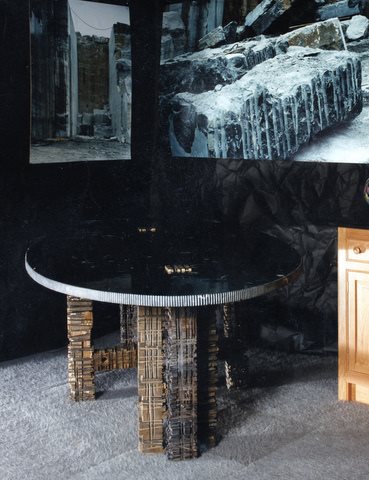Kilkenny City - or 'The 'Marble City' as it is widely known - is situated in the midst of substantial limestone deposits and limestone is to be seen everywhere - in the buildings, their doorways and the steps up to them, in the wonderful medieval effigies in St Canice's Cathedral and the Black Abbey, as tombstones, pavements, walls and more and more....
'Marble' is, in fact, a misnomer but is eloquent of the fact that the quality of 'Kilkenny blue limestone' (which is what it is) allows it to take on a polished-finish like that of marble and which reveals its inherent, natural beauty.
For all these reasons I was aware of limestone, and its wide range of uses, from the moment I settled in Kilkenny in 1972/3.
But it was not until the early 1980's, when I was working at Castletown Cox* in Owning, south Kilkenny, for the inimitable and exotic Baron Brian de Breffny, that I first had cause to use it myself.
My task was to replace the back-entrance gate-piers.
I will not dwell (for now anyway) on that time or that project, but it was my research into and the search for suitable limestone for the job that first opened my eyes to its potential for use in furniture.
* (Castletown Cox is itself built of limestone ashlars by Ducart in the 1760's, and remains one of Ireland's finest, small, eighteenth century, country houses).
This research led me to what was then Kellymount Quarry above Paulsown, Co. Kilkenny, where Jim Kirby (now of Leinster Stone), managed operations. It changed hands subsequently and is today called Kilkenny Blue Limestone, the generic name of the material itself.
And this slab was my first personal purchase of limestone.
It was straight off the saw and I did no more than square it, cut-off the corners and arris its edges with an angle grinder and put it on a simple base of locally-grown Spanish chestnut. It has been in use since, in various spaces and places, here at home. - Right now, as you can see, it is an outdoor, table and it lives under a canvas gazebo all summer.
As with so many things, technology in the stone industry has moved on massively over the past twenty years.
Back in the 1980's the blocks that had been extracted from the quarry were converted into slabs on frame-saws before being cut to dimension by overhead, circular beam-saws which cut through the slabs and into the 6” x 6” timber skids that supported them.
A block extracted from the quarry waiting to be sawn into slabs on a frame saw.
Skids that I gleaned from the quarry back then, still in a corner of a storeroom.
Skids had only a limited useful life before, having been scored once too often by saw cuts, they became unstable supports for the slabs. By this time they had been impregnated by the solution of limestone dust created by the water that was used to cool the saw blades as they cut the stone.
I thought, and I still do, that they have a wonderful natural sculptural quality and in time, as the quarry became one of my favourite haunts and I had become more familiar with limestone, they inspired the design for a table that I exhibited at 'Showcase', an annual trade show for the craft industry run by the Crafts Council of Ireland. I think it was in 1990.
You will see that I used the skids, that had been used during the cutting of the slab, as described, to now provide the supports for the table-top. And, in the flutes around the edge of the table-top, I sought to pick-up the drill-holes that had been created during the extraction of the block from the quarry.

The table on the stand at Showcase

The skid supports and the fluted edge-detail

The table under construction

...and nearing completion
And this is a stylised version that I built for the NTMA

Note the fossils in the polished limestone.
...and the density of them in this top on bookshelves in my own house.
This question of there being fossils in the stone, takes me all the way back to the beginning of this brief look at limestone.
It had always been my understanding that, what was referred to as 'Kilkenny Marble', was totally black limestone (when polished): stone that was thus completely blemish (or fossil) free. This, I further understood, was extracted, principally, from the Black Quarry (now defunct), situated adjacent to the present Bennettsbridge roundabout on Kilkenny's ring road and one or two other quarries, now also exhausted, one of which was in Gowran.
While doing a little research, to check my facts, I asked a number of Kilkenny folk what they thought Kilkenny marble was. To a man, they didn't understand my question: 'Sure, Kilkenny Marble is Kilkenny Marble isn't it? It's marble'.
I then came upon an article, published in the Kilkenny People some time back, which was largely based on an interview with Jim Harding of Hardings Fireplaces in Gowran. His comments, as reported, appeared to contradict my understanding of the Kilkenny Marble / Limestone question.
By the by, I always called it Kilkenny Limestone.
I decided that there was nothing for it but to contact the Harding's to check out the facts further. - They after all have been in the stone business for generations, both as quarrymen and processors.
So off I went for a chat with Philip Harding and John Walsh at Technical Stoneworks in Bagenalstown who supplied me with a superbly executed limestone top for a break-front pier table I designed and made for the Merrion Hotel last year.
The pier table in the drawing room at the Merrion Hotel.
And this is what I discovered.
My understanding of the issue appears to have been right on most points except that Kilkenny Marble is not necessarily fossil-free, though the fossils in stone extracted from the Black Quarry tend to be much smaller than those in Kellymount stone: but then again, the quantity and the size of fossil can vary greatly in different areas and beds in any limestone quarry.
At the heel of the hunt, in geological terms, it is all limestone but, for reasons unknown, it has locally, long been known as Kilkenny marble, particularly the stone from the Black Quarry, which was so widely used in building the city.
And, to end, here I am discussing Kilkenny Limestone with the former taoiseach!

